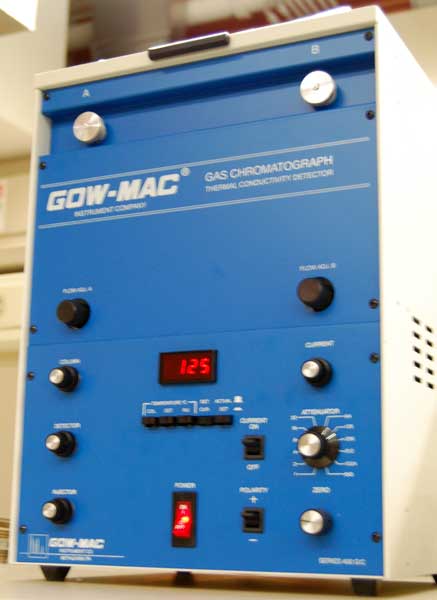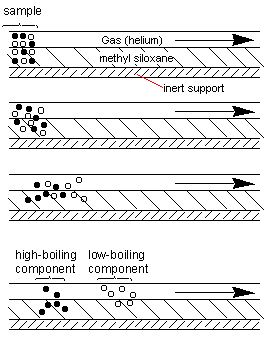Gas chromatography is a means of separating a volatile mixture. The components of this mixture may only be a few tenths of a degree different in boiling point, but can still be separated by GC.
APPARATUS
In Chem0330 at Pitt, the GC machine is called the Gow-Mac:

and is equipped with a packed column. This column consists of a high molecular weight polymer, methyl siloxane, adhered to an inert support. This is the stationary phase. As with the other forms of chromatography, a mobile phase passes through the column. The carrier gas must be inert- helium is the carrier gas used in Pitt's Gow-Mac. The sample is injected into an injector port which vaporizes all of the components. The sample then dissolves in the methyl siloxane and then a component evaporates into the gas phase. This component and the carrier gas travel down the column, redissolve, and evaporate again. This continues until the component and helium reach the detector. The figure below illustrates the separation of a two component system.


The detector in Pitt's Gow-Mac are thermal conductivity detectors. These detectors measure the change in the resistance of a heated Tungsten wire as pure carrier gas then the mixture of helium and organic compound pass over the wire. The detector sends this information to the chart recorder which allows for quantification and identification. Identification can be achieved if a standard solution is also injected and the retention time (tR) is calculated for each component, as performed in Chem0330. Quantification of the amount of each component is found by calculating the area under each peak in the chromatograph.
RETENTION TIME
The retention time is given by the following equation:

The retention time is dependent on the temperature of the GC, the rate of flow of carrier gas, and the speed of the chart recorder.
GC SETTINGS
These settings should not be changed after the standard solution has been injected since matching retention times of the sample components with those of the standard solution is essential for identification. The sample is injected with a microsyringe as gas chromatography requires very little sample. Treat the syringe with care, as it is fragile and can easily be bent. Also be careful not to touch any part of the injector port. This chamber is extremely hot (over 300 degrees Celsius!) in order to vaporize the sample - inject carefully!!